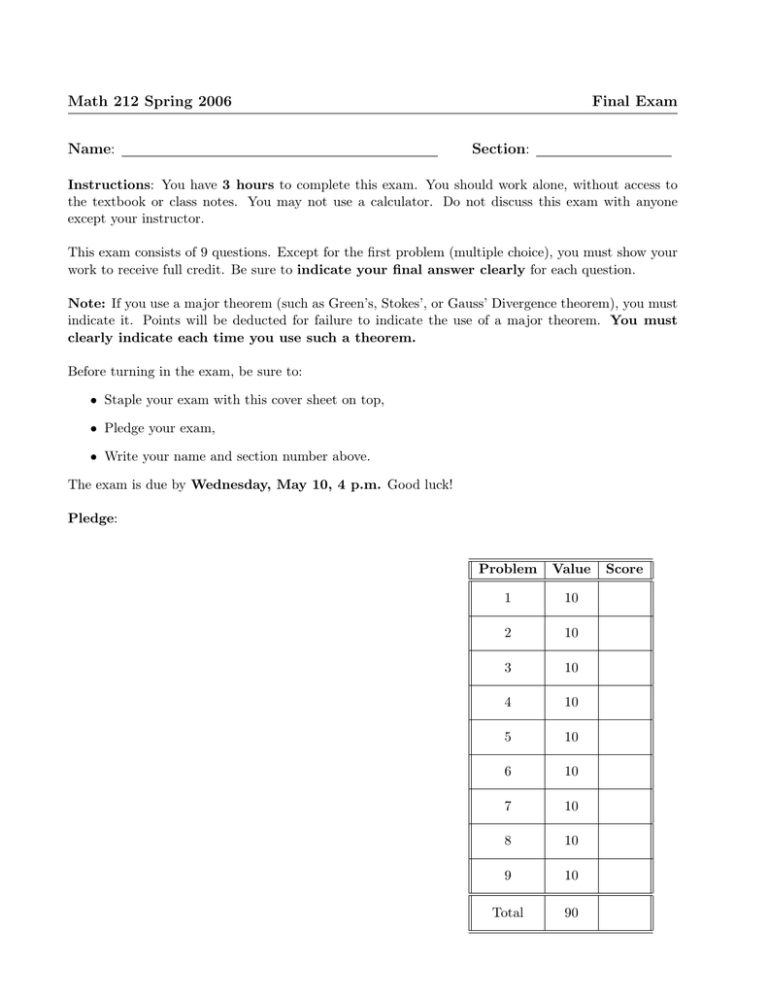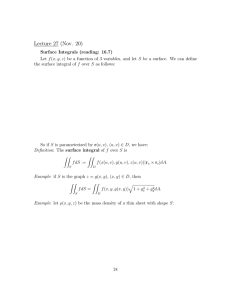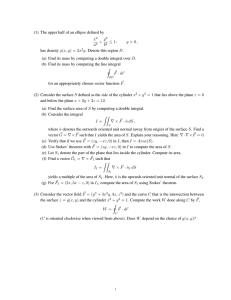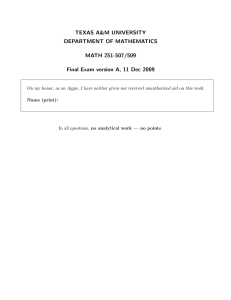Math 212 Spring 2006 Final Exam Name: Section:
advertisement

Math 212 Spring 2006 Name: Final Exam Section: Instructions: You have 3 hours to complete this exam. You should work alone, without access to the textbook or class notes. You may not use a calculator. Do not discuss this exam with anyone except your instructor. This exam consists of 9 questions. Except for the first problem (multiple choice), you must show your work to receive full credit. Be sure to indicate your final answer clearly for each question. Note: If you use a major theorem (such as Green’s, Stokes’, or Gauss’ Divergence theorem), you must indicate it. Points will be deducted for failure to indicate the use of a major theorem. You must clearly indicate each time you use such a theorem. Before turning in the exam, be sure to: • Staple your exam with this cover sheet on top, • Pledge your exam, • Write your name and section number above. The exam is due by Wednesday, May 10, 4 p.m. Good luck! Pledge: Problem Value 1 10 2 10 3 10 4 10 5 10 6 10 7 10 8 10 9 10 Total 90 Score 1. In the following problem, let S be a unit disk in the plane z = 5, centered at (0, 0, 5), and oriented upward. Let C be a straight path from (2, 2, 2) to (0, 0, 0). Also, let f (x, y, z) = xy 2 z 3 , F(x, y, z) = −yi + xj, G(x, y, z) = 3i + j + 2k. Now, for each of the given quantities, decide if it is positive, negative, or zero. (You do not need to justify your answers. No partial credit will be given.) ZZ (a) ∇ × F · dS. S Z (b) ∇f · ds. C ZZ (c) F · dS. S ZZ (d) G · dS. S Z (e) ∇f · ds. ∂S 2. (a) Find all critical points of the function g(x, y) = 2y 3 − 6y + x2 in R2 and classify them. (b) Let B be the unit ball in R3 , i.e. the set of points (x, y, z) satisfying x2 + y 2 + z 2 ≤ 1. Let f (x, y, z) = 2x + 4y + 6z. Find the minimum and maximum values of f restricted to B. 3. (a) Let f (x, y) be a C 1 function whose domain is the unit disk in the xy–plane, such that f (x, y) ≥ 0 everywhere. Suppose that the level set f (x, y) = 0 is exactly the unit circle. Let S be the graph of f (x, y), oriented upward, and let F(x, y, z) = curl(x2 − z, ez + 2x, π). ZZ F · dS. Determine S (b) Let g(x, y) be a C 1 function whose domain is the unit disk in the xy–plane, such that g(x, y) ≤ 0 everywhere. Suppose that the level set g(x, y) = 0 is exactly the unit circle. Let T be the graph of f (x, y), oriented downward. ZZ F · dS. Determine T Z 4. Evaluate 0 √ 7 33 Z √ 7 √ 3 3 p x( 1 + y 7 ) dy dx. x Hint: Consider the region of integration. 5. Let W be the region in space under the graph of f (x, y) = (cos y) exp(1 − cos 2x) + xy over the region in the xy-plane bounded by the line y = 2x, the x axis, and the line x = π/4. (a) Find the volume of W . (b) Let F = 5xi + 5yj + 5zk be the velocity field of a fluid in space. Calculate the flux of F through the boundary ∂W of W , where W is the region from (a). 2 2 6. Let S be a surface in R3 given as follows. p S is the portion of the cylinder x + y = 9 lying above z = 0, below the graph of z = x2 + (y − 3)2 , and with y ≤ 0. (a) Set up, but do not evaluate, an integral giving the surface area of S. (b) Suppose S is made ofra thin metal whose mass density at any point is given by the y function f (x, y, z) = 1 − . Find the total mass of S. 3 7. Let g(x, y) = xey . (a) Compute the second-order Taylor formula for g around (3, 0). (b) Approximate 2.9e0.1 . (c) Compute the directional derivative of g based at (3, 0) in the direction of fastest increase. 8. Let F(x, y) = 2xyi + x2 j. Show that the line integral of F around the triangle T (oriented counterclockwise) with vertices (0, 0), (0, 1) and (1, 1) is zero in the following three ways: (a) parameterizing T and evaluating the integral directly, (b) showing F is a gradient vector field and explaining why the integral is zero, and (c) using Green’s Theorem. 9. Compute the flux of the vector field G(x, y, z) = (xy 2 , yz 2 + y, zx2 + 1) through the unit sphere, oriented outward.



